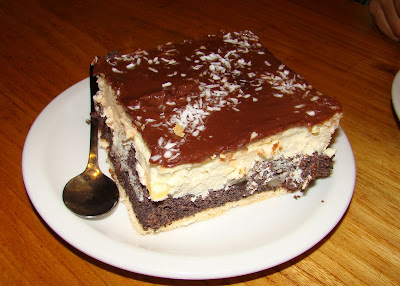
Christmas in the beautiful Tatras Mountains in the south of Poland feels to be the closest thing to spending time with Santa at the end of a travel by the Polar Express. The temperature is 10 t0 15 degrees below zero, and the Christmas trees on the roundabouts look like those on picture postcards.
One thing the weather does is that you do not feel so bad eating all the atery clogging food and heaps of it. Why should fat be any less harmful in cold weather is anyone's guess! The food in the hills is very distinct from its neighbouring areas in the plains hardly 50 kms away.
The ethnic group inhabiting these mountains ("gory" is mountains and hence "gorale") is believed to comprise of Polish, Czech, Ukrainian, Vlach and Slovak shepherds. So it comes as no surprise, that while lamb is a rare premium meat across Poland, here in the mountains you get the best of it - and none of the farm-fed industrial variety. My lamb sausages (at Karczma Slimak, a touristy replica of tradional Inns) were fabulous with really strong flavour of the meat (not like the sausages in frankfurters and hotdogs where the sausauge could have been made with soya and you wouldnt know) (Kilebaski baranie z cebula - that's lamb suasage with onions)


The other speciality is Oscypek, a smoked cheese made from ewe's milk. It is generally sliced and grilled and eaten with crandberry preservve (zurawina). While grilling gives it a chewy texture, the salty-somky taste is amazing.

You can even buy this cheese from many street hawkers lining the tourist areas and grill it on a griddle at home - we always do!

Another thing that strikes you is that portions are more American than European. Every meal seems to be a Christmas feast, and no place highlights it more than Kolibecka, a highly recommended place on a busy roundabout (no one speaks English here, and you have to order food at the bar and find a seat for yourselves).  The food is amazing and portions twice the size of standard American ones. My portion of Golonka (fat enveloped pork knuckles) was full 1 kilogram by weight.
The food is amazing and portions twice the size of standard American ones. My portion of Golonka (fat enveloped pork knuckles) was full 1 kilogram by weight.
 The food is amazing and portions twice the size of standard American ones. My portion of Golonka (fat enveloped pork knuckles) was full 1 kilogram by weight.
The food is amazing and portions twice the size of standard American ones. My portion of Golonka (fat enveloped pork knuckles) was full 1 kilogram by weight. Even the dessert seemed to be two standard portions of cake served together - a cake with the goodness of poppy seeds:
Even the dessert seemed to be two standard portions of cake served together - a cake with the goodness of poppy seeds:
And in the true spirit of Christmas, why use the popular winter local transport:

Jingle bells, jingle bells,
Jingle all the way;
Oh! what fun it is to ride
In a one-horse open sleigh.
PS: At a restaurant on one of the ski slopes, I was served trout which, I thought, was presented in an interesting manner - with a small flames buring on trout head and tail!










